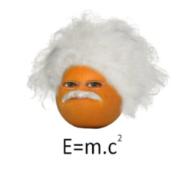1.)In this lab, you confimed the presence of carboxylic acids by their ability to form esters in the presence of an acid catalyst.
Which of the following compounds correctly represents the product in the condensation (esterification) reaction between butanoic acid and propanol?
click link to see the compounds:
http://picasaweb.google.com/110376515801820978243/Question1#
a.)A
b.)B
c.)C
d.)D
e.)E
2.)Which of the following compounds would:
--be insoluble in water and insoluble in a weak solution of NaHCO3
--give a negative result with CrO4-
--give a negative test with a bromine solution
click link to see the compounds:
http://picasaweb.google.com/110376515801820978243/Question2#5464590414265046482
a.)I
b.)II
c.)III
d.)IV
e.)V
f.)none of these compounds (I - V) would give these results
3.)You have samples of two different compounds, C3H6 and C3H6 (structural isomers).
Which one of these tests can be used to distinguish between the pair of compounds shown above?(hint:You should draw out the two compounds they have and consider if they are primary, secondary, or tertiary.)
a.)H2CrO4
b.)NaHCO3 solution
c.)Br2 in CH3CCl3
d.)dilute HCl
e.)heptane/water solubility
4.)Shown below are some organic compounds, similar to the compounds studied in this experiment.
which of the following compounds would you expect to be "water soluble" and which would you expect to be" hexane soluble"?
click the link see the compounds:
http://picasaweb.google.com/110376515801820978243/Question4#
a.)water soluble or hexane soluble
b.)water soluble or hexane soluble
c.)water soluble or hexane soluble
d.)water soluble or hexane soluble
e.)water soluble or hexane soluble
f.)water soluble or hexane soluble
organic chem easy
2010-04-27 3:32 pm
回答 (3)
2010-04-27 5:43 pm
✔ 最佳答案
1.)In this lab, you confimed the presence of carboxylic acids by their ability to form esters in the presence of an acid catalyst.Which of the following compounds correctly represents the product in the condensation (esterification) reaction between butanoic acid and propanol?
a.)A
b.)B
c.)C
d.)D
e.)E
圖片參考:http://imgcld.yimg.com/8/n/HA04717316/o/701004270020013873388060.jpg
2.)Which of the following compounds would:
--be insoluble in water and insoluble in a weak solution of NaHCO3
--give a negative result with CrO4-
--give a negative test with a bromine solution
a.)I
b.)II
c.)III
d.)IV
e.)V
f.)none of these compounds (I - V) would give these results
Be insoluble in water and insoluble
in a weak solution of NaHCO3:
III, IV, V
As they can form ionic salt with NaHCO3(aq).
give a negative result with CrO4-:
CrO4- is a fairly strong oxidizing agent.
I, IV, V give –ve result.
give a negative test with a bromine solution:
Do not react with Br- ions.
I, II
3.)
a.)H2CrO4
b.)NaHCO3 solution
c.)Br2 in CH3CCl3
d.)dilute HCl
e.)heptane/water solubility
圖片參考:http://imgcld.yimg.com/8/n/HA04717316/o/701004270020013873388061.jpg
Br2(aq) decolourized when reacted with propene, howver,
cyclopropane does not.
4.)Shown below are some organic compounds, similar to the compounds studied in this experiment.
which of the following compounds would you expect to be "water soluble" and which would you expect to be" hexane soluble"?
a.)water soluble or hexane soluble
b.)water soluble or hexane soluble
c.)water soluble or hexane soluble
d.)water soluble or hexane soluble
e.)water soluble or hexane soluble
f.)water soluble or hexane soluble
A is hexane-soluble as it is an organic compound.
B is water-soluble as it is a carboxylic acid and only has fewer than 5 carbon atoms.
C is hexane-soluble, although it is a carboxylic acid, it has a long carbon chain and the larger hydrocarbon portion, which is hydrophobic
D is water-soluble as you can see it exists in ion form.
E is hexane-soluble as it has a long carbon chain and the larger hydrocarbon portion, which is hydrophobic
F is hexane-soluble as it is an organic compound.
2010-04-27 19:05:38 補充:
Thanks 老爺子
參考: 撼頭埋牆
2010-04-27 6:46 pm
thanks for the correction .老爺子
2010-04-27 6:40 pm
2. answer : e (V).
be insoluble in water and insoluble in a solution of NaHCO3: I, II, III, V
Only IV (a carboxylic acid) reacts with NaHCO3 to give soluble carboxylate salt.
give a -ve test with a bromine solution : II, V
I, III and IV contains C=C double bonds, which undergoes addition with Br2.
2010-04-27 10:42:47 補充:
4(a). water soluble as C=O is very polar and the hydrocarbon chain is short. Actually, ethanal (a) is soluble in water in all proportions.
Reference:
http://en.wikipedia.org/wiki/Ethanal
be insoluble in water and insoluble in a solution of NaHCO3: I, II, III, V
Only IV (a carboxylic acid) reacts with NaHCO3 to give soluble carboxylate salt.
give a -ve test with a bromine solution : II, V
I, III and IV contains C=C double bonds, which undergoes addition with Br2.
2010-04-27 10:42:47 補充:
4(a). water soluble as C=O is very polar and the hydrocarbon chain is short. Actually, ethanal (a) is soluble in water in all proportions.
Reference:
http://en.wikipedia.org/wiki/Ethanal
收錄日期: 2021-05-01 01:01:40
原文連結 [永久失效]:
https://hk.answers.yahoo.com/question/index?qid=20100427000051KK00200



